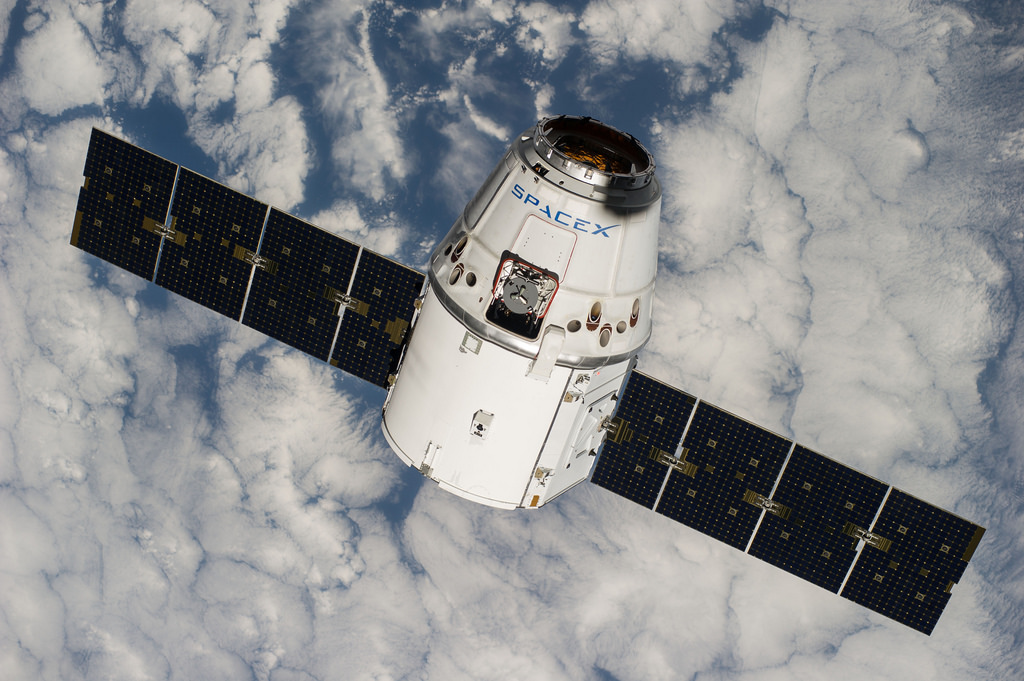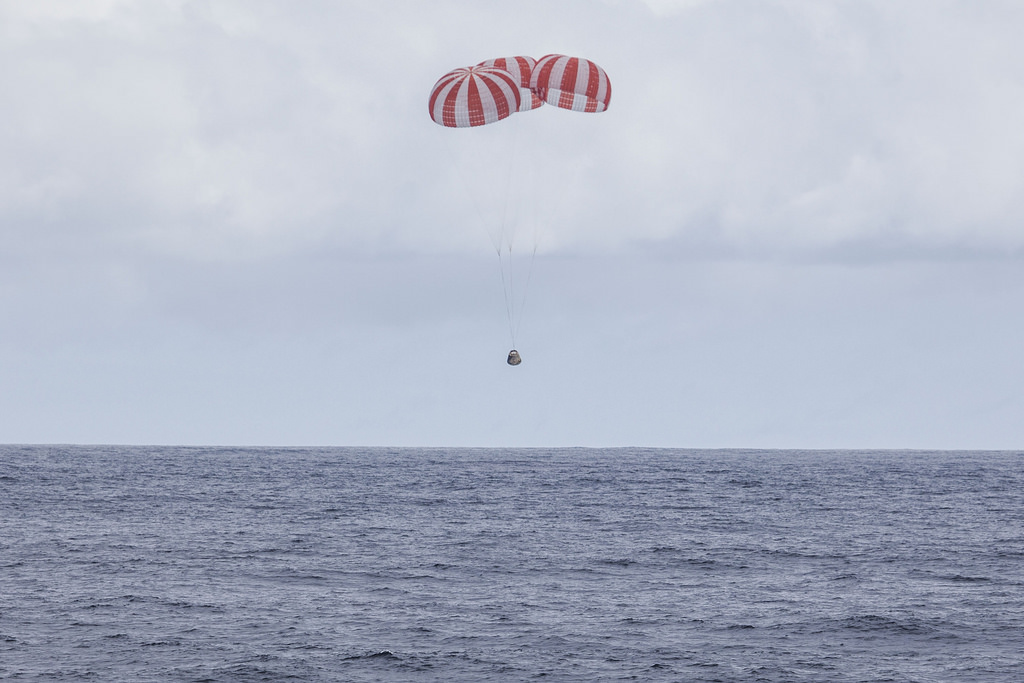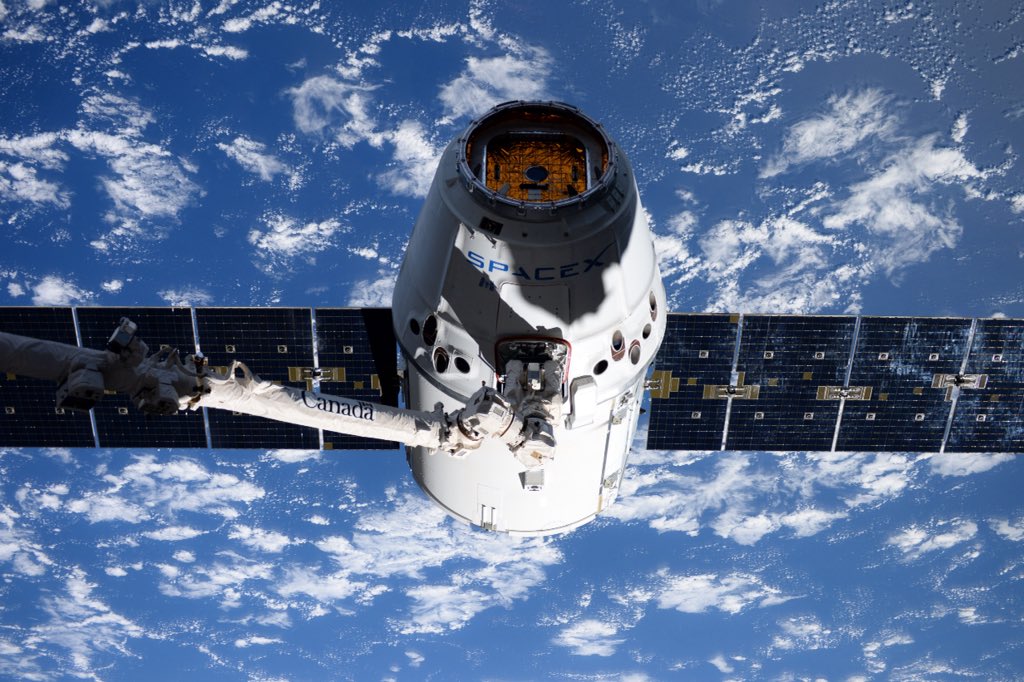
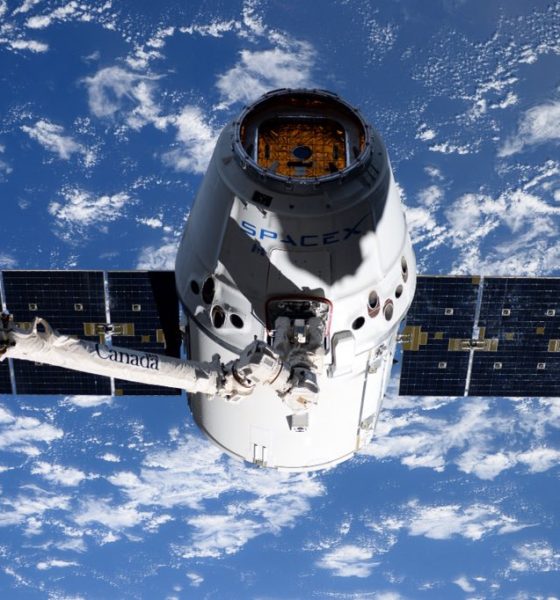
SpaceX
What SpaceX’s successful reuse of Dragon Spacecraft really means
Following Saturday’s auspicious launch and and first stage recovery, SpaceX’s Dragon spacecraft has successfully rendezvoused and docked with the International Space Station. Bringing with it more than 5,000 pounds of food, water, scientific experiments, and technology demonstrations, the company’s eleventh mission under their first Commercial Resupply Services contract is exceptional for a very unique and specific reason: the vehicle has flown before, bringing cargo to the ISS on SpaceX’s fourth CRS mission to the ISS. This accomplishment makes the Dragon currently docked at the ISS the only commercial spacecraft in human history to be launched into orbit more than once, continuing a tradition of auspicious firsts.
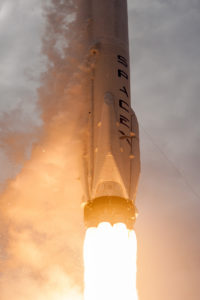
CRS-11 just after liftoff. Note the core designation “35” under the landing leg. (SpaceX)
Slightly more than two months after the first ever successful reuse of an orbital-class rocket, SpaceX now has two extraordinary demonstrations of success in favor of the company’s pursuit of democratizing affordable access to space. Reusability is and has been SpaceX’s method of pursuing that goal for at least a decade, with Musk publicly exhorting the potential benefits of rapid and complete reusability as early as 2007. It is almost a running joke within the community of aerospace and SpaceX fans that Musk will compare commercial airlines to orbital launch services at least once every time he is interviewed, but his point is and has long been clear. If all one has to do to run a transportation service is refuel after every trip, the price of a ticket or cargo transport drastically decreases. While many have slyly laughed or dismissed this goal in the past, often using the Space Shuttle as an example of the futility of reusability as a tool for cost reduction, it is quite hard to deny what SpaceX has accomplished so far.
The reuse of a Cargo Dragon is also arguably far more significant than it may initially appear. SpaceX has not provided any concrete information on the process of refurbishing the capsule, and it is entirely unclear if the “reuse” entailed much more than furnishing the CRS-4 pressure vessel and Draco thrusters with a new trunk, solar array, external shell. It is possible that, just like SES-10, the process of refurbishing a spacecraft for the first time resulted in little to no cost savings, and that this refurbishment took anywhere from several months to more than a year, with the CRS-4 capsule returning from orbit in late 2014. However, given the absolute rarity of reused capsule-type spacecraft, the data that engineers likely gathered throughout the process of refurbishing the Dragon would arguably make the whole process worthwhile even in the worst case scenarios described above. Hans Koenigsmann, Vice President of Mission Assurance at SpaceX, also noted in a press conference following CRS-11’s launch that the refurbishment of the capsule was somewhat uneventful, stating that the CRS-4 capsule had no unanticipated damage from the rigors of reentry and ocean landing and that SpaceX was already ready to consider using the capsule a third time. It’s likely that SpaceX will begin to rely more heavily on Cargo Dragon reuse as they refocus a majority of their manufacturing efforts on Dragon 2.
- The CRS-4 Dragon just before capture. (NASA)
- CRS-4 reentered in late 2014 and was recovered in the Pacific Ocean. (SpaceX)
SpaceX and Musk’s (in)famous ultimate ambitions are to make humanity a multiplanterary species, partly as a way to combat the extinction risks that an asteroid or comet strike pose, and partly because it is simply a staggering challenge that has the potential to make many humans “excited to wake up in the morning”. In order to make this happen, Musk saw that access to orbit was far too expensive for a colony on another planet to ever be sustainable, and that resuability was the only immediately obvious and accessible method through which the price to orbit could be decreased by several magnitudes. SpaceX is now almost routinely recovering Falcon 9 first stages when the mass of the payload allows it, and with a fifth and final version or “Block” of the vehicle optimized for rapid reuse set to debut later this year, Musk and others at the company have begun ruminating once more about the possibility of recovering and reusing the second stage of the Falcon 9. Benchmarked somewhere around 30% of the price of the vehicle, routine loss of the second stage effectively prevents the price of the Falcon 9 from dropping much below $20-30 million US dollars. While a nearly 50% or greater reduction in price would be an exceptional accomplishment, it is still far from from the multiple orders of magnitude reduction Musk hoped for when he set out to develop reusable rocketry.
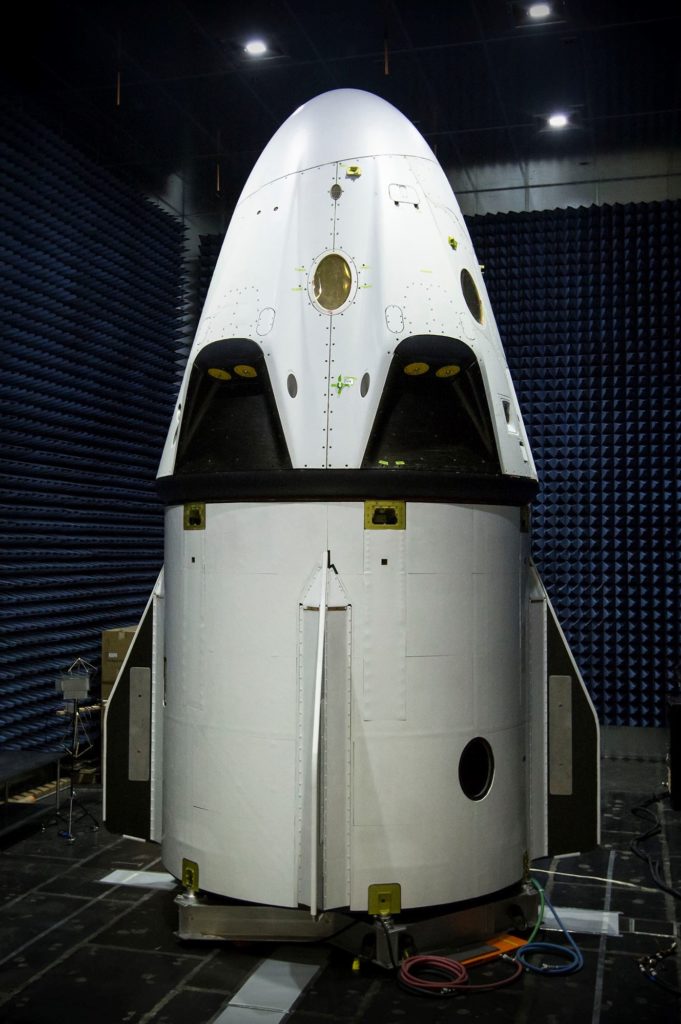
A prototype of Dragon 2 being tested in an anechoic chamber. (SpaceX)
This is where the reuse of Dragon pops its head up. With second stage recovery now being considered theoretically and Dragon 2 (Crew Dragon) preparing to begin regular launches in either Q4 2017 or Q1 2018, SpaceX has a good deal of experience to gain from learning how to safely and rapidly recover and reuse vehicles reentering the atmosphere at orbital velocity. Compared to recovering the first stage, this is another endeavor entirely. The fastest speed at which a recoverable first stage can ever realistically reenter the atmosphere is currently capped at around 5200 mph (2300 m/s), and is usually much closer to 3000 mph. An orbital capsule like Dragon, however, enters the atmosphere from Low Earth Orbit (LEO) at around five times that speed, typically close to 16,000 mph. In the context of recovering the second stage of Falcon 9, one must consider that most of SpaceX’s commercial manifest is made up of geostationary satellites, which require more energy to reach a higher orbit, and consequently would require the second stage to survive even higher reentry velocities in order to be recovered.
Returning from Mars, as SpaceX’s Interplanetary Transport System would have to, results in even higher reentry velocities of at least 25,000 mph for a reasonably quick journey. This is the most important detail in explaining the true value of simply reusing a Dragon capsule as SpaceX has just now done. By taking its first steps towards routinely reusing truly orbital spacecraft, SpaceX is advancing their knowledge reusability in practice and consequently taking concrete steps to prepare themselves for the difficult challenges that lie ahead in their pursuance of enabling sustainable colonization of Mars. Dragon 2 (Crew Dragon) promises to eventually rid the refurbishment process of the many headaches that salt water intrusion undoubtedly creates by returning via supersonic retropropulsion to a landing pad, much like Core 35 did this past Saturday.
Looking slightly further into the future, SpaceX has already announced plans to launch two unnamed private customers in a Dragon 2 on what would likely be a circumlunar free return trajectory, or around the Moon and back. The reentry velocity would be very similar to the velocity required to return to Earth from Mars, and certainly much faster than any reentry from geostationary orbits of Earth. If SpaceX manages to successfully and reliably recover and reuse orbital vehicles reentering at such high velocities, then the company will have made extraordinarily promising progress towards achieving their central goal of drastically lowering cost to orbit and thus enabling humanity to gain footholds on other planets.
So, take this Dragon reuse as you will. It may well be a major step along the way to colonizing Mars, or it may simply be an exciting practical implementation of SpaceX’s philosophy of reuse. Either way, this is a Dragon that is certainly worth celebrating.

Elon Musk
SpaceX issues statement on Starship V3 Booster 18 anomaly
The incident unfolded during gas-system pressure testing at the company’s Massey facility in Starbase, Texas.

SpaceX has issued an initial statement about Starship Booster 18’s anomaly early Friday. The incident unfolded during gas-system pressure testing at the company’s Massey facility in Starbase, Texas.
SpaceX’s initial comment
As per SpaceX in a post on its official account on social media platform X, Booster 18 was undergoing gas system pressure tests when the anomaly happened. Despite the nature of the incident, the company emphasized that no propellant was loaded, no engines were installed, and personnel were kept at a safe distance from the booster, resulting in zero injuries.
“Booster 18 suffered an anomaly during gas system pressure testing that we were conducting in advance of structural proof testing. No propellant was on the vehicle, and engines were not yet installed. The teams need time to investigate before we are confident of the cause. No one was injured as we maintain a safe distance for personnel during this type of testing. The site remains clear and we are working plans to safely reenter the site,” SpaceX wrote in its post on X.
Incident and aftermath
Livestream footage from LabPadre showed Booster 18’s lower half crumpling around the liquid oxygen tank area at approximately 4:04 a.m. CT. Subsequent images posted by on-site observers revealed extensive deformation across the booster’s lower structure. Needless to say, spaceflight observers have noted that Booster 18 would likely be a complete loss due to its anomaly.
Booster 18 had rolled out only a day earlier and was one of the first vehicles in the Starship V3 program. The V3 series incorporates structural reinforcements and reliability upgrades intended to prepare Starship for rapid-reuse testing and eventual tower-catch operations. Elon Musk has been optimistic about Starship V3, previously noting on X that the spacecraft might be able to complete initial missions to Mars.
Elon Musk
SpaceX Starship Version 3 booster crumples in early testing
Photos of the incident’s aftermath suggest that Booster 18 will likely be retired.

SpaceX’s new Starship first-stage booster, Booster 18, suffered major damage early Friday during its first round of testing in Starbase, Texas, just one day after rolling out of the factory.
Based on videos of the incident, the lower section of the rocket booster appeared to crumple during a pressurization test. Photos of the incident’s aftermath suggest that Booster 18 will likely be retired.
Booster test failure
SpaceX began structural and propellant-system verification tests on Booster 18 Thursday night at the Massey’s Test Site, only a few miles from Starbase’s production facilities, as noted in an Ars Technica report. At 4:04 a.m. CT on Friday, a livestream from LabPadre Space captured the booster’s lower half experiencing a sudden destructive event around its liquid oxygen tank section. Post-incident images, shared on X by @StarshipGazer, showed notable deformation in the booster’s lower structure.
Neither SpaceX nor Elon Musk had commented as of Friday morning, but the vehicle’s condition suggests it is likely a complete loss. This is quite unfortunate, as Booster 18 is already part of the Starship V3 program, which includes design fixes and upgrades intended to improve reliability. While SpaceX maintains a rather rapid Starship production line in Starbase, Booster 18 was generally expected to validate the improvements implemented in the V3 program.
Tight deadlines
SpaceX needs Starship boosters and upper stages to begin demonstrating rapid reuse, tower catches, and early operational Starlink missions over the next two years. More critically, NASA’s Artemis program depends on an on-orbit refueling test in the second half of 2026, a requirement for the vehicle’s expected crewed lunar landing around 2028.
While SpaceX is known for diagnosing failures quickly and returning to testing at unmatched speed, losing the newest-generation booster at the very start of its campaign highlights the immense challenge involved in scaling Starship into a reliable, high-cadence launch system. SpaceX, however, is known for getting things done quickly, so it would not be a surprise if the company manages to figure out what happened to Booster 18 in the near future.
Elon Musk
SpaceX’s next project will produce Starships at a level that sounds impossible
1,000 rockets per year is an insane number, especially considering Starship’s sheer size.

Elon Musk has revealed bold plans for SpaceX’s newest Starbase facility in Texas, predicting it will become a birthplace for “so many spaceships.” The upcoming “Gigabay,” a massive $250 million production hub in Starbase, Texas, is designed to manufacture up to 1,000 Starship rockets per year.
That’s an insane number of rockets for a single facility, especially considering Starship’s sheer size.
One of the world’s largest industrial structures
SpaceX’s Gigabay is expected to stand roughly 380 feet tall and enclose 46.5 million cubic feet of interior space, making it one of the largest industrial structures to date. The facility will feature 24 dedicated work cells for assembling and refurbishing Starship and Super Heavy vehicles, complete with heavy-duty cranes capable of lifting up to 400 U.S. tons, as noted in a Times of India report.
Construction crews have already placed four tower cranes on-site, with completion targeted for December 2026. Once operational, the Gigabay is expected to boost SpaceX’s launch cadence dramatically, as it would be able to build up to 1,000 reusable Starships per year, as noted in a report from the Dallas Express. Musk stated that the Gigabay will be “one of the biggest structures in the world” and hinted that it represents a major leap in Starbase’s evolution from test site to full-scale production hub.
A key step toward Mars and beyond
Starship is SpaceX’s heavy-lift rocket system, and it remains a key part of Elon Musk’s vision of a multiplanetary future. The vehicle can carry 100–150 tonnes to low Earth orbit and up to 250 tonnes in expendable mode. With several successful flights to date, including a perfect 11th test flight, the Starship program continues to refine its reusable launch system ahead of crewed lunar missions under NASA’s Artemis initiative.
Starship is unlike any other spacecraft that has been produced in the past. As per Elon Musk, Starship is a “planet-colonizer” class rocket, as the magnitude of such a task “makes other space transport task trivial.” Considering Starship’s capabilities, it could indeed become the spacecraft that makes a Moon or Mars base feasible.
